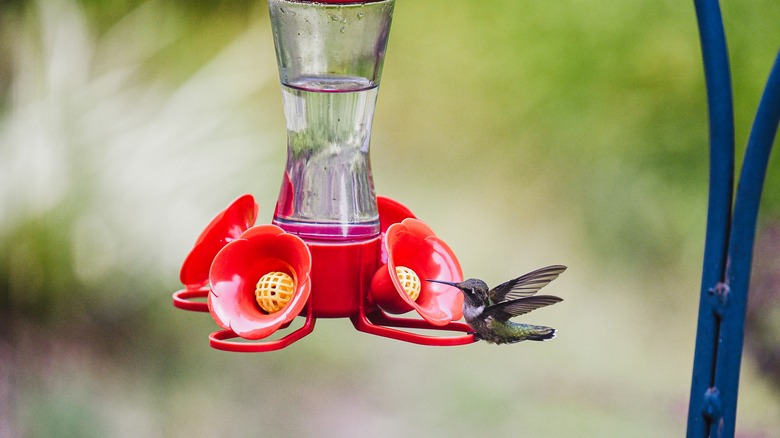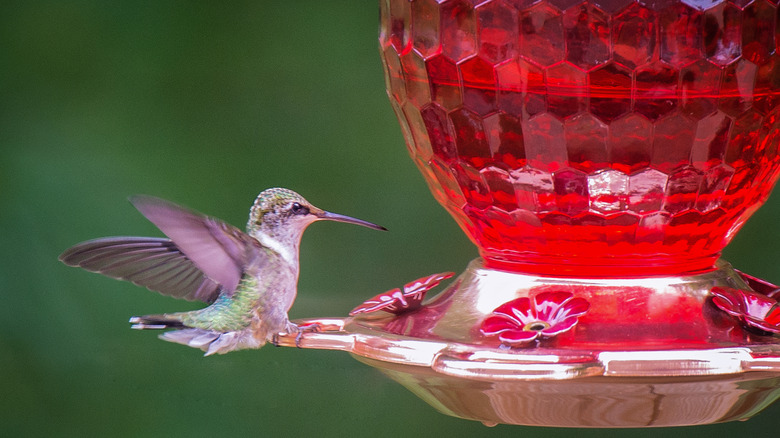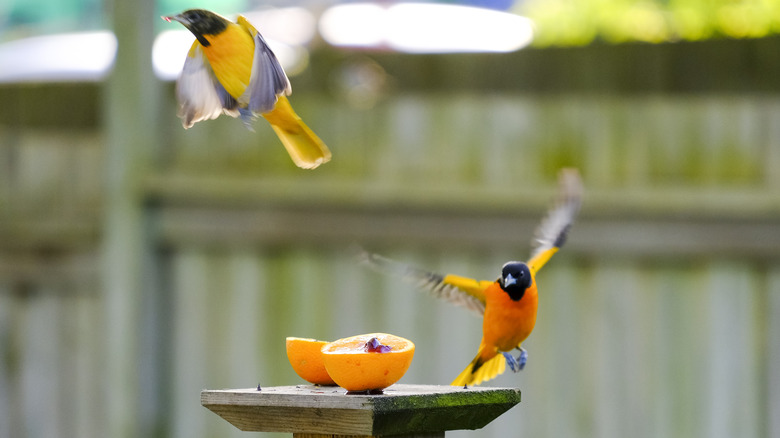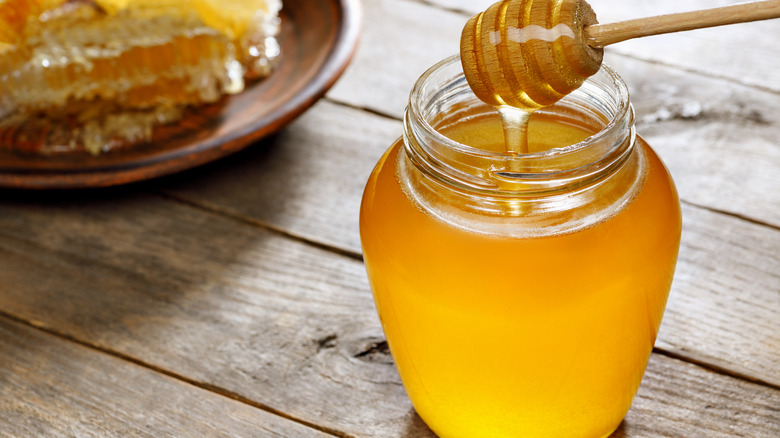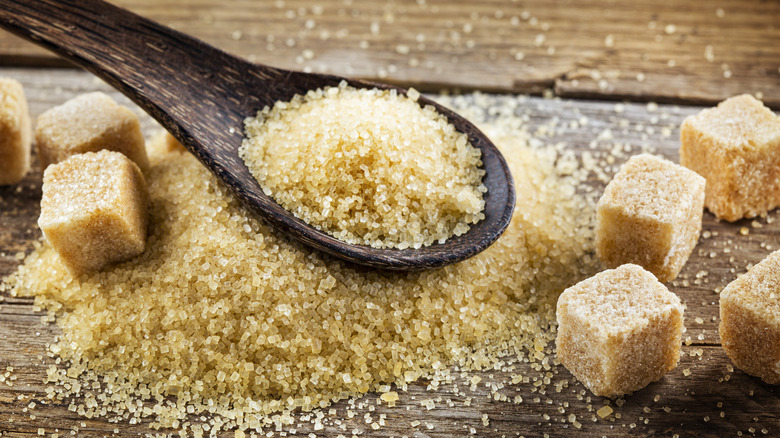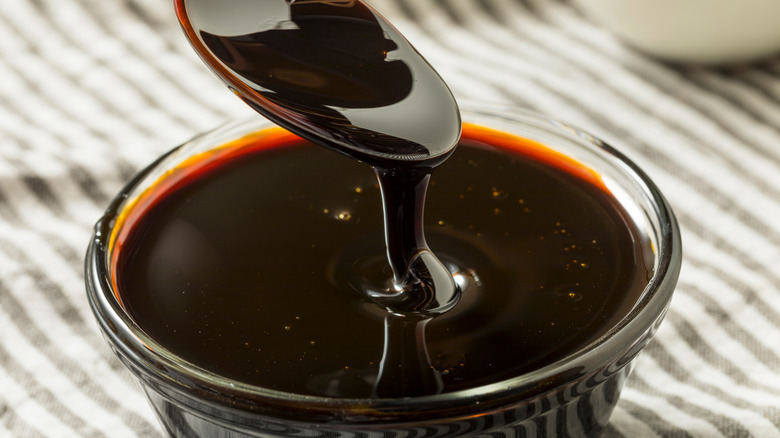Ingredients You Should Never Feed The Hummingbirds Visiting Your Yard
Hummingbirds are one of the most beloved backyard visitors for bird-watching pros and general nature lovers alike. Their iridescent feathers, delicate bodies, and furiously fluttering wings are a magnetic and enthralling sight. In the U.S., we spend an estimated $1 billion every year on bird feeders and other paraphernalia, some no doubt on the pretty floral-inspired looks of the specialty feeders required for hummingbirds, who eat something called simulated nectar, a mixture of sugar water specifically formulated for a hummingbird's delicate constitution. Therefore, it's important not to feed them ingredients their bodies can't handle. Items like food coloring, fruit juices, honey, and raw, organic, or specialty sugars are harmful to hummingbirds and should never be mixed into their feeders.
Hummingbirds are tiny, and yet their high energy, constant motion, rapid heartbeat, and huge heart (2.5% of their total body mass, compared to a human's 0.3%) requires that they eat approximately twice their body weight every single day. Their diet consists of both live insects for protein and nectar for energy. Simulated nectar can be made with a simple solution of four parts water and one part pure cane granulated sugar that is fully dissolved. Homemade hummingbird nectar is surprisingly easy to make.
Say goodbye to dye
Hummingbirds love the color red, which often attracts them to certain flowers and nectar feeders. And, when you walk through your local garden center or home improvement store, you'll often find plastic jugs of ruby red hummingbird nectar. However, you want to skip adding this to your hummingbird feeder because these dyed nectar solutions contain artificial dyes. Specifically, they may contain Red Dye 40, which has been linked to physical and mental ailments in humans. Though there haven't been clinical studies to prove it is harmful to hummingbirds, it is still recommended by hummingbird experts to avoid feeding it to them. At best, it's unnecessary as hummingbirds are attracted to red flowers, not red nectar (which is colorless), and at worst, it could prove to be harmful. Instead, there are plenty of other harmless clever ways to add red to your garden to attract more hummingbirds.
Today's best practices recommend using clear, dye-free nectar solutions and feeders accentuated with red at the feeding spouts. This is why so many of these spouts are fashioned to look like long red flowers. Another option, whether you're looking to buy a less traditional feeder or want to make one yourself, is to use red-stained glass for your nectar reservoir, which will catch a hummingbird's eye without altering the composition of the nectar.
Boot the fruit
Given that hummingbirds partly subsist on nectar, some people may assume that the sugars from fresh fruit might be an even better, more natural option. This actually isn't the case. Organic fruits and their juices are more susceptible to fermentation. Additionally, they turn to rot and mold faster than a plain sugar water mixture would. Even something like watermelon, with an incredibly high water content, will likely spoil rapidly. Artificial juices are no better because of their dyes and potential chemical additions. Plus, these options are highly attractive to ants, which hummingbirds tend to avoid.
Other fruit options hazardous to hummingbirds are jellies, jams, and preserves. Setting out grape jelly for migrating orioles has become a popular pastime, but leaving it out year-round or putting watered-down versions into your DIY hummingbird feeders has led to these fragile creatures being found in critical condition, covered in the sticky substance. It is best to avoid such substances altogether.
No, no honey
Hummingbirds are susceptible to a fungal infection known as candidiasis. It causes tongue swelling and makes it difficult for the birds to eat, if not impossible. This fungus grows out of environments teeming with bacteria formed by the decay of organic matter, particularly mixtures of honey and water that have started to ferment. Sugar water can ferment, too, but if you safely clean your hummingbird feeders out every couple of days and replace the mixture, it'll remain safe for the birds to drink. Honey mixed with water will ferment much faster, however. And its stickiness makes it a lot harder to clean.
Moreover, raw honey is known to carry the bacterium known to cause infant botulism (also called intestinal botulism), which mainly affects children under the age of one. This is one of the reasons parents are discouraged from feeding their babies honey, but many people don't know that animals can also contract botulism, including birds. Botulism in birds can cause paralysis of the wings, legs, neck, and eyelids, which could lead to their death. While this has been noted most often in poultry and waterfowl, botulism has proved deadly in hummingbirds, too.
Don't get fancy
There are many different types of sugar on the market these days, but basic granulated white cane sugar is the way to go when mixing up nectar for your hummingbird feeder. For strict vegans who abstain from cane sugar that may be processed with animal products, beet sugar is an acceptable substitute. Other types of sugar are harmful to hummingbirds. First, if you use artificial sweeteners at home and don't generally keep real sugar on hand, you won't provide enough caloric energy to fuel the birds' frenetic flights. Secondly, if you're out of cane sugar and think you can substitute it with confectioners' sugar, think again. Powdered sugar contains anti-caking agents, which are chemical additives that prevent dry foods from lumping together. These are not healthy for the birds.
As for crystallized sugars, they aren't any better. Raw, organic, turbinado, and even brown sugars have a greater concentration of vitamins and minerals inside the crystals. This is simply too much for the hummingbirds' tiny bodies and rapid metabolism. The minerals build up, and the birds get sick as a result. This could be one of many reasons hummingbirds are steering clear of your yard.
Iron out the details
Another reason brown sugar is terrible for hummingbirds is because it contains molasses, which gives it that signature color. Molasses has a high iron content, and iron is a particularly dangerous mineral for hummingbirds. Their bodies do not have protection against absorbing too much, and so when they ingest large amounts, it gets stored in their livers and other organs, causing iron toxicosis. Any foods containing elevated iron levels should be kept away from hummingbird feeders.
In addition to brown sugar and molasses, other iron-rich foods to avoid leaving in your backyard if you hope to have a healthy visitation of hummingbirds include figs, raisins, prunes, maple syrup, and dark chocolate. Agave syrup, while only containing trace amounts of iron, may still be considered too much. It's best to avoid it. Stick to the basics and be very particular about how you prepare and care for your hummingbird feeder, as this is one of the many ways to help birds during migration season as they fly up to 4,000 miles across the continent.
